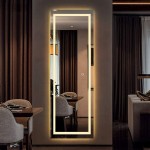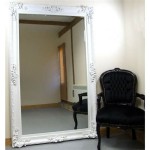DIY Mirror Jewelry Storage: Combining Function and Style
The challenge of organizing jewelry is a common one. Necklaces tangle, earrings lose their pairs, and bracelets disappear into the abyss of drawers. Traditional jewelry boxes often lack the capacity and organizational features to effectively manage a growing collection. A DIY mirror jewelry storage solution presents a practical and aesthetically pleasing alternative. This project combines the functionality of a full-length mirror with the organizational benefits of a hidden jewelry compartment.
This type of storage offers several advantages beyond simple organization. It conserves space, eliminating the need for both a bulky jewelry box and a separate full-length mirror. The mirror itself contributes to the décor of the room, while the hidden storage compartment keeps jewelry out of sight, reducing clutter and potential theft. Furthermore, crafting a DIY solution allows for customization to perfectly match individual jewelry collections and personal style preferences.
Planning and Design Considerations
The first step in creating a DIY mirror jewelry storage unit involves careful planning and design. This stage determines the overall aesthetic, dimensions, and functionality of the finished product. Key considerations include the size of the mirror, the depth of the storage compartment, the type of hinges and closures, and the interior organization.
The mirror's size should be proportional to the space where it will be placed. A full-length mirror provides the most practical view for getting dressed, but a smaller, wall-mounted option may be more suitable for smaller rooms. The depth of the storage compartment dictates how much jewelry can be stored and how bulky the unit will appear. A deeper compartment allows for more layers of jewelry and thicker items like watches, but it will also protrude further from the wall. The width of the frame will also contribute to determining the overall depth.
The type of hinges and closures chosen will affect both the functionality and the appearance of the unit. Concealed hinges offer a clean, minimalist look, while decorative hinges can add a touch of vintage charm. Magnetic closures are a simple and effective way to keep the door securely closed, while more elaborate latches can provide added security. The safety of the mirror itself is paramount; using shatter-resistant glass is highly recommended, even if it adds to the cost.
Interior organization is crucial for maximizing storage capacity and preventing jewelry from becoming tangled or damaged. Features to consider include hooks for necklaces, slots for earrings, cushioned rolls for rings, and adjustable shelves for larger items. The specific configuration should be tailored to the types and quantities of jewelry in the collection.
Materials and Tools
The materials required for this project will vary depending on the design and construction methods chosen. However, some essential components include lumber for the frame and backing, a mirror of the desired size, hinges, closures, and interior organization materials. The quality of the materials will directly impact the durability and longevity of the finished product.
The type of lumber used for the frame will influence the overall aesthetic. Hardwoods like oak, maple, or cherry offer superior strength and durability, but they are also more expensive and require more advanced woodworking skills. Softwoods like pine are more affordable and easier to work with, but they may be less resistant to wear and tear. Plywood can be used for the backing and interior components, providing a stable and cost-effective alternative to solid wood.
For interior organization, consider using materials like felt, velvet, or leatherette to line drawers and trays, protecting jewelry from scratches and damage. Small hooks, metal rods, and clear plastic dividers can be used to create custom storage solutions for different types of jewelry. LED strip lighting can be added inside the compartment to illuminate the jewelry and make it easier to find specific pieces. This lighting can run off battery power or be hardwired into a power source.
Essential tools for this project include a saw (circular saw, miter saw, or hand saw), a drill, a screwdriver, a measuring tape, a level, sandpaper, wood glue, screws, and finishing supplies (paint, stain, varnish). Depending on the complexity of the design, additional tools like a router, a jigsaw, or a nail gun may also be required. Safety equipment, such as safety glasses and ear protection, is essential when working with power tools.
Construction and Assembly
The construction process begins with building the frame that will house the mirror and the storage compartment. Precise measurements and accurate cuts are crucial for ensuring a square and stable frame. The frame can be assembled using wood glue and screws or nails. Clamps should be used to hold the pieces together while the glue dries.
Once the frame is assembled, the backing is attached. This can be done using plywood or solid wood. The backing should be securely fastened to the frame with screws or nails, ensuring a flush and even surface. The mirror is then carefully inserted into the frame and secured with mirror clips or adhesive. It is important to handle the mirror with care to avoid scratches or breakage. Securing the mirror with adhesive can provide extra support and prevent rattling.
Next, the hinges are installed on the frame and the door. The door should be aligned properly to ensure smooth opening and closing. The closures, such as magnetic catches or latches, are then installed to keep the door securely closed. Adjustable hinges can be useful for fine-tuning the alignment of the door. Careful attention to detail during this step is essential for a functional and aesthetically pleasing finished product.
The interior organization components are then installed within the storage compartment. This may involve attaching hooks for necklaces, installing earring slots, and mounting ring cushions. Adjustable shelves can be added to accommodate larger items. The specific configuration should be tailored to the individual's jewelry collection. Lining the interior with felt or velvet will protect the jewelry from scratches and add a touch of luxury.
Finishing and Installation
The final step involves finishing the exterior of the mirror jewelry storage unit. This may include sanding the surfaces smooth, applying a coat of primer, and painting or staining the wood. The choice of finish will depend on personal preferences and the existing décor of the room. Polyurethane or varnish can be applied to protect the finish and provide a durable surface.
Before applying the finish, all surfaces should be thoroughly sanded to remove any imperfections. The primer will help the paint or stain adhere properly to the wood. Multiple coats of paint or stain may be required to achieve the desired color and coverage. Allow each coat to dry completely before applying the next. A clear topcoat will protect the finish and make it more resistant to scratches and wear.
Once the finish is dry, the mirror jewelry storage unit can be installed on the wall. It is important to use appropriate mounting hardware to ensure that the unit is securely attached. The type of mounting hardware will depend on the weight of the unit and the type of wall it is being installed on. Stud finders can be used to locate wall studs, which provide the strongest support. The unit should be leveled properly to ensure that it hangs straight. Using a level during installation is essential for achieving a professional-looking result.
Finally, the jewelry can be organized and stored inside the compartment. Arrange the jewelry in a way that maximizes space and prevents tangling. Ensure that the door closes securely and that the mirror is clean and free of smudges. Consider adding a small light inside the compartment to illuminate the jewelry and make it easier to find specific pieces. Regular dusting and cleaning will help keep the mirror and the storage compartment looking their best.

Diy Jewelry Organizer Shanty 2 Chic

Diy Jewelry Organizer Shanty 2 Chic

How To Build A Mirrored Wall Mount Jewelry Cabinet Interior Frugalista

Diy Over Door Jewelry Display Mirror

Diy Full Length Mirror With Storage Addicted 2

Diy Mirror Jewelry Storage

How To Build A Sliding Mirror Jewelry Cabinet Designed Decor

How To Diy A Built In Jewelry Organizer

How To Build A Mirrored Wall Mount Jewelry Cabinet Interior Frugalista

How To Build A Sliding Mirror Jewelry Cabinet Designed Decor








